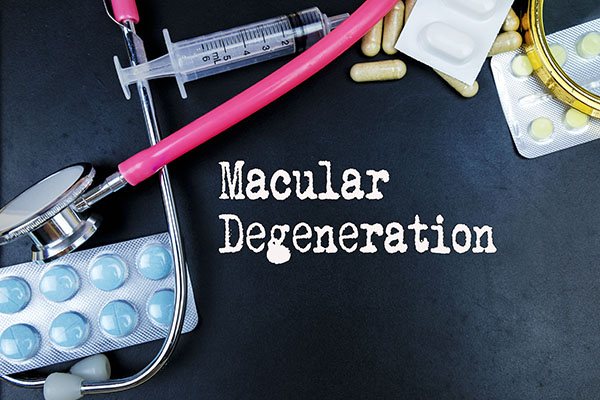
Did you know that one in every five people over the age of 65 will be diagnosed with Age-Related Macular Degeneration?
Age-Related Macular Degeneration is often under-discussed and is not a commonly understood condition. This February is Age-Related Macular Degeneration month, and at Diagnostic Eye Center we want to educate our patients and the Houston community about the implications, symptoms, and lifestyle habits that can help prevent this disease.
What is age-related macular degeneration?
Age-related macular degeneration, or AMD as it’s called, occurs when the macula deteriorates. The macula is an important part of the retina.
After all, the retina is what sends nerve signals to the brain and translates them into the images that we see. It makes sense then, that any damage to the retina would cause our sight to be affected.
In the case of AMD, arteries that help keep the macula going begin hardening. When these crucial arteries harden, the retinal tissues start breaking down. These retinal tissues eventually die.
When the macula is no longer sustained by the arteries, we start seeing vision loss. An unsustained macula means your central vision is no longer sharp and crisp.
In AMD, vision loss usually starts with the loss of your central vision. Although AMD is one of the leading causes of blindness for people fifty and over, it takes time to get there.
Wet and dry age-related macular degeneration
Many people learning about age-related macular degeneration don’t realize there are two kinds. These are wet and dry. Of the two kinds, the most common is dry AMD.
Wet age-related macular degeneration occurs when the eye produces new blood vessels. These new blood vessels grow in the retina, but they are weak compared to the ones that died.
This results in the new blood vessels leaking blood and fluids into the retina’s layers. As you can imagine, there’s nothing good about blood leaking into the retina. This results in the visual distortion that’s typical with AMD.
The other problem with the leaking blood vessels is they leave scar tissue on the retina. Another symptom for people with wet age-related macular degeneration is seeing dark spots. These happen because of the scar tissue that’s left behind on the retina.
The second kind of age-related degeneration is the dry kind, which is more common. In dry AMD, there are no leaking blood vessels in the retina.
Patients with dry age-related macular degeneration instead form small particles called drusen. Drusen very slowly cause deterioration of the retina and macula.
Sometimes this step can take years. Once deterioration has occurred, there is vision loss. Dry age-related macular degeneration can later advance into wet age-related macular degeneration.
Could I have age-related macular degeneration?
If you think you could have age-related macular degeneration, you should go see your eye doctor. It’s only during a comprehensive eye exam that AMD can even be diagnosed!
Here are some things that make you at a higher risk for developing AMD:
● Being over the age of 50, which is the highest risk factor
● Being a smoker. Smoking doubles your risk of developing AMD
● Having a family history of age-related macular degeneration
● Poor lifestyle choices like leading a sedentary life, unhealthy diet, and high blood pressure
AMD symptoms to watch out for
AMD is a stealthy disease – there are symptoms you can keep an eye on, but we wouldn’t rely on them. Why? AMD takes a long time to develop.
Usually, when you notice symptoms like vision loss, you’ve already developed age-related degeneration. If you want to be smart and proactive, see your eye doctor for eye exams regularly!
This gives you the best chance that they’ll catch it in the early stages if you do have AMD. Early detection and early treatment are your best weapons with age-related macular degeneration.
If you are watching out for symptoms of age-related macular degeneration, it’s these:
● an area of dark spots in the middle of your vision
● blurry vision
● becoming unable to see things clearly over time
● the loss of your color vision
The tricky thing about these symptoms is they also overlap with other eye conditions. If you notice any of these symptoms, go see your eye doctor.
You may not have age-related macular degeneration, but they could detect another condition.
Decreasing risk of developing age-related macular degeneration
If you are “high risk” for age-related macular degeneration, you may be wondering if you can change that.
We can’t guarantee you’ll never develop AMD but there are things you can do to decrease your risk.
Eat healthy, live healthy
It’s simple, but it’s a crucial part of reducing your AMD risk. Eating a healthy diet filled with lots of fruits and vegetables can make a big difference. When you’re overhauling your diet, make sure you’re including plenty of leafy vegetables.
We’re talking about spinach, kale and collard greens. It’s easier to incorporate these into your diet than you think! Add a morning smoothie to your routine filled with berries, bananas, and kale.
Since there are other ingredients in your smoothie, you’ll barely notice the kale. Spinach can be a great addition to your salads, or as a side vegetable sautéed in olive oil.
Get up and move!
A healthy diet isn’t going to do much for you if you never exercise. It’s no coincidence that high blood pressure and cholesterol are high AMD risks.
Do whatever it takes to get up and get your heart pumping! Ideally, you should be exercising thirty minutes a day, three days a week. It can be as simple as taking your dog on a beautiful hike or swimming at your local gym.
Don’t tell us you can’t keep track of how much you’re exercising, either! There are hundreds of varieties of Fitbits, Apple Watches, and fitness trackers to help everyone track their daily goals. Come up with a goal and stick to it. Your eyes and your body will thank you!
If a fitness tracker isn’t for you, try simply tracking the amount of time spent walking, running, or engaging in other physical activities daily. The Department of Health and Human Services recommends 150-300 minutes of moderate activity each week to begin experiencing the benefits of regular activity.
Stop smoking if you’re a smoker
We all know smoking is bad for you. It damages your teeth, makes your lungs weak, and can have other negative health implications. But you can add one more to the list: smoking doubles your risk of developing AMD!
Yikes. Imagine a world where your vision has been compromised. That could be your future if you smoke regularly and develop age-related macular degeneration.
Schedule an Eye Exam at Diagnostic Eye Center
Can’t remember the last time you had an eye exam or saw your eye doctor? This February, do something about it in honor of AMD Awareness Month!
Contact our expert vision care team at Diagnostic Eye Center in Houston, Texas for an appointment today! A comprehensive eye exam can assist in the early detection of Age-Related Macular Degeneration.

